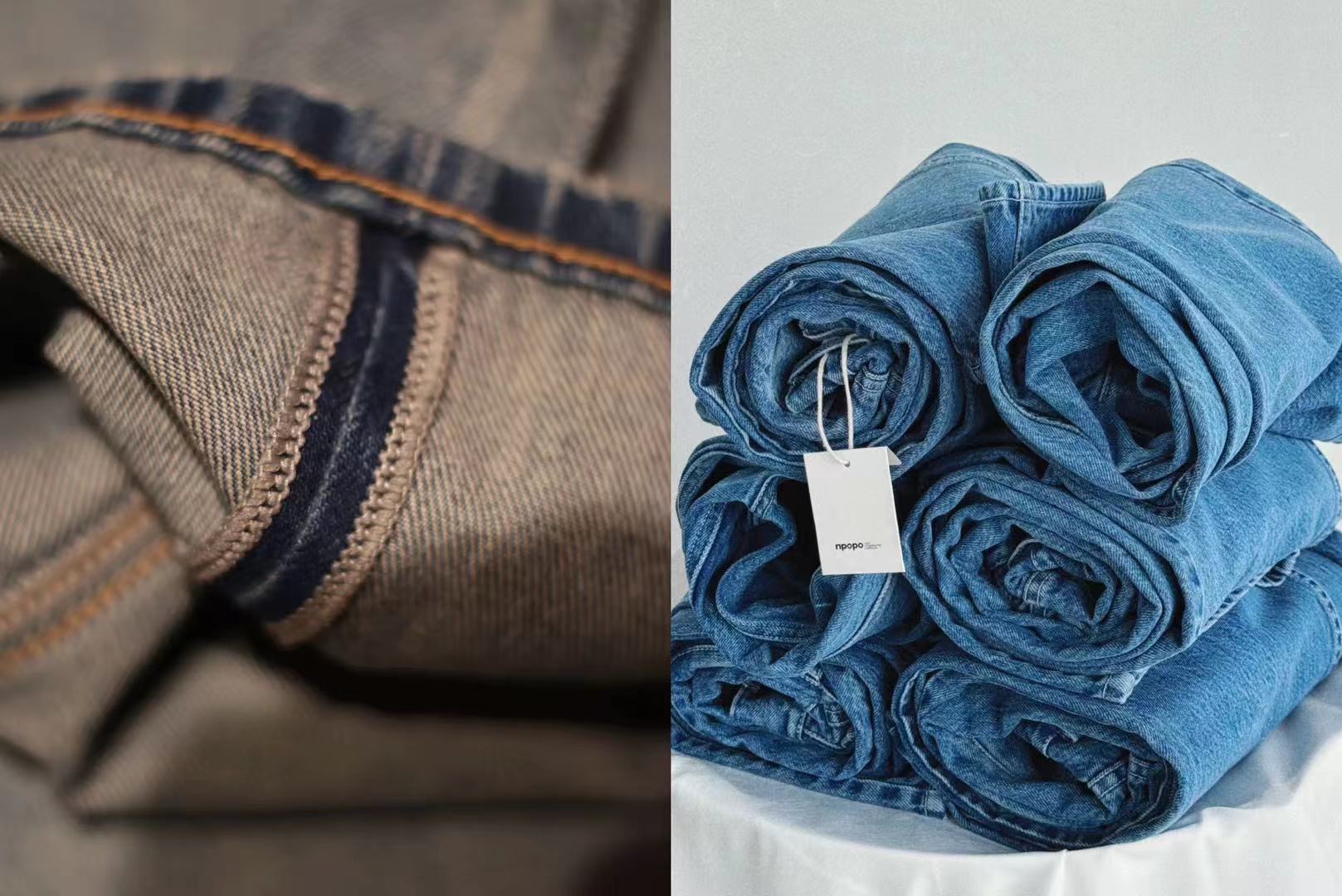Styles révolutionnaires en denim Selvedge

Temps de lecture estimé : ~4 minutes
What Is Denim Selvedge?
Selvedge denim is the tightly woven edge sur premium jeans, often finished with a colored thread. In other words, it’s literally the “self-edge” of the tissu. As Levi Strauss & Co. historian Tracey Panek notes, selvedge (or selvage) is a vertical edge of the tissu denim that prevents it from unraveling. Le clean, bound edge has become a hallmark of quality denim. Selvedge denim gets woven on traditional shuttle looms, qui créent un tight narrow fabric avec natural edges that do not fray. Historically, the blue jean was born in 1873 when Levi Strauss and tailor Jacob Davis patented metal rivets sur work pants, and for over a century Japan became the epicenter of premium selvedge production. Unlike modern stretch denim, selvedge is often sold raw (unwashed) so that wearers can break it in themselves. Selvedge denim does not inherently possess force but it develops a distinctive texture which people value as it ages.

Selvedge Denim jeans
From Pure Twill to Slub Texture: A Tactile Revolution
Classic selvedge denim is usually woven in a smooth, even twill. Manufacturers now use slub yarns—thicker uneven threads that create purposeful bumps et irregularities in their products. The tissu develops a vintage artisanal appearance right after the first use. About 20% de denim haut de gamme today uses slub yarns. The result is a “salt-and-pepper” or streaky appearance et very personalized fading. In fact, the thick segments de slub yarn wear down faster in high-stress areas like the knees et seat, producing dramatic “whiskers” et honeycomb fades that are unique to each wearer. As one denim guide explains, slub-infused selvedge denim starts off with a subtle vertical streakiness et marble-like texture, making the eventual fades more striking. Le tactile innovation apporte durabilité avec vintage style to create a look that resembles worn jeans from the factory.
The Color Revolution: Beyond Blue and White
Traditionally, denim lisière is indigo on the outside with a white weft backing, mais modern trends have exploded the palette de couleurs. Brands are now weaving black, deep indigo, yellow, et même pastel ou neon selvedge fabrics. Le industrie de la mode reports that denim coloré provides consumers with a fashionable alternative à traditional blue jeans for those who want to express their style personnel. Common innovative combinations include:
-
Black-on-black: UN sleek, minimalist look where even the trame is dyed black.

-
Deep indigo/white: UN rich indigo base that transforms into bright white as time passes to create strong visual contrast.

-
Yellow/white: UN vibrant summery hue which creates a strong contrast with the white weft.

Demand pour non-traditional colors has surged among younger consumers: many Millennials et Gen Z shoppers now favor vibrant denim hues over classic blue. Le new color palette does not affect the fade characteristics of these selvedge fabrics, which maintain their raw denim fade potential. The process of washing et wearing denim results in distinctive patinas qui créent un dynamic et personal appearance for each vêtement. In short, colorful selvedge denim allows people to show their personality while maintaining the deep fades et craftsmanship that selvedge is famous for.
Edge Artistry: Red Isn’t the Only Color
Le selvedge edge, which people commonly refer to as the “redline,” serves as a traditional status indicator, mais modern designers now use it to create artistic designs. For example, Cone Mills developed a red selvedge exclusively for Levi’s 501® jeans in 1927: a single red thread running through the white edge to identify the tissu as Levi’s denim. Brands have started using colored selvage IDs dans black, yellow, green, et rainbow stripes in the present day. As one fashion editor notes, concepteurs are using “rainbow selvedge” and “redlisted selvedge” edges as celebratory accents. The act of cuff rolling reveals these bursts of color, which makes the selvedge edge a unique personal identifier. Le strong accents serve to distinguish brands while enabling customers à personalize their fashion choices between basic black selvedge edges et playful yellow stripes, which create an unmistakable modern look.
Sustainable Innovations in Selvedge Denim
Durabilité is reshaping denim lisière. Le textile industry has adopted coton biologique, recycled fibers, et innovative eco-friendly dyes in many mills to decrease environmental impact. Brands that focus on durabilité dans denim production are attracting more customers. The implementation of new dyeing et finishing techniques leads to substantial water conservation because these methods decrease water usage by approximately 40% relative to conventional methods. The use of lasers ou ozone instead of harsh chemicals helps to minimize water consumption. Plant-based dyes et natural indigo alternatives provide both new color options et eco-friendly alternatives. Sustainable selvedge denim maintains the same apparence et durabilité as traditional denim because it requires less water et fewer toxic chemicals pendant production. The modern eco-selvedge fabric collection provides ethical fashion peace of mind à consommateurs who value durabilité while maintaining the durabilité that selvedge fabric is known for.
Hybrid Weaves: Blending Tradition and Innovation
Selvedge denim contains hybrid weaves which combine sergé avec chevrons ou sergé brisé patterns in addition to slub textures. Le detailed patterns create visual interest et un gentle touch which appeals to contemporary consumers. The use of multiple yarns crée intricate zigzag patterns et broken diagonal lines which attract the eye. Denim enthusiasts report rising demand for these hybrid selvedge fabrics, as they maintain the force de classic selvedge while feeling more pliable. Hybrid weaves establish a market position through their combination of durabilité avec confort et innovative design elements which create stylish versatile selvedge jeans et vestes.
Pros and Cons of Selvedge Denim
Avantages
-
Durabilité exceptionnelle (often lasting much longer than mass-produced denim).
-
Truly unique aging (raw selvedge develops highly personalized fades).
-
High craftsmanship appeal.
-
Many selvedge options are also more eco-friendly: for example, using sustainable materials et processes can cut water usage by about 40%. These qualities make denim lisière desirable for quality-conscious consumers.
Inconvénients
-
Premium price – the cost of shuttle-loom production et premium materials typically puts selvedge 15–25% above standard jeans.
-
New selvedge denim can also be initially stiff; the raw fabric usually needs weeks of wear à soften et conform to your body.
-
Vibrant dyed selvedge fabrics are less common, so some color/edge styles may be hard to find dans mass-market stores.
Conclusion
Selvedge denim exists as a developing textile which combines traditional manufacturing methods avec modern design aspects. From textured slub yarns et vibrant new hues à bold selvage IDs et eco-conscious materials, today’s selvedge jeans et vestes go far beyond their workwear roots. Le premium denim market is growing, and these revolutionary styles ensure that selvedge remains an icon of authentic, personalized fashion. Embracing these trends lets you craft pièces en denim that are as versatile as they are timeless – your next chef-d'œuvre en denim is waiting to be worn in.
Services de personnalisation par LYDENIM
Vous recherchez des tissus denim haut de gamme ou des vêtements en denim sur mesure ? LYDENIM propose des solutions sur mesure pour donner vie à votre vision créative grâce à des textures uniques et de haute qualité.
🎨 Tissus personnalisés: Discover our premium selvedge denim collection and design your own fabrics with a variety of colors, patterns, and textures that suit your style. Explore our offerings at lydenim.com.
🛍️ Vêtements personnalisés: Create distinctive selvedge denim pieces with our luxurious fabric weaves, from cozy jeans to sophisticated jackets. Choose your favorite colors and styles to customize on Myalibaba.
📩 Contactez-nous: Contactez notre équipe au malone@lydenim.com pour discuter de vos idées de tissus ou de vêtements, des motifs de tissage aux mélanges écologiques.
Donnez vie à votre vision unique avec LYDENIM, votre partenaire de confiance pour des tissus denim innovants et des solutions vestimentaires personnalisées.
